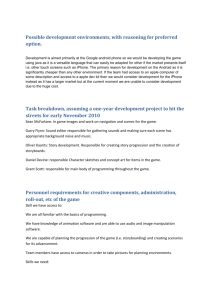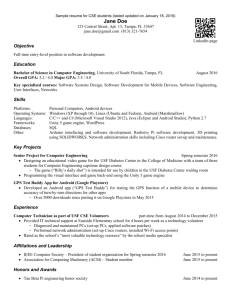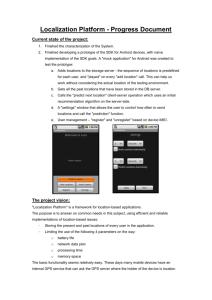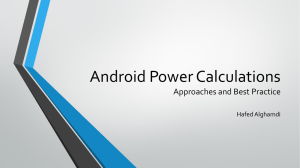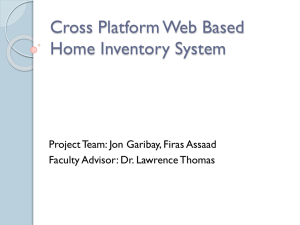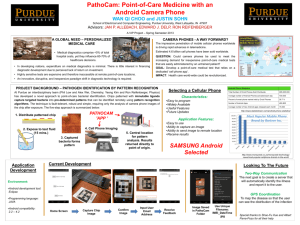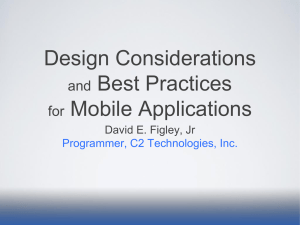Lecture1
advertisement
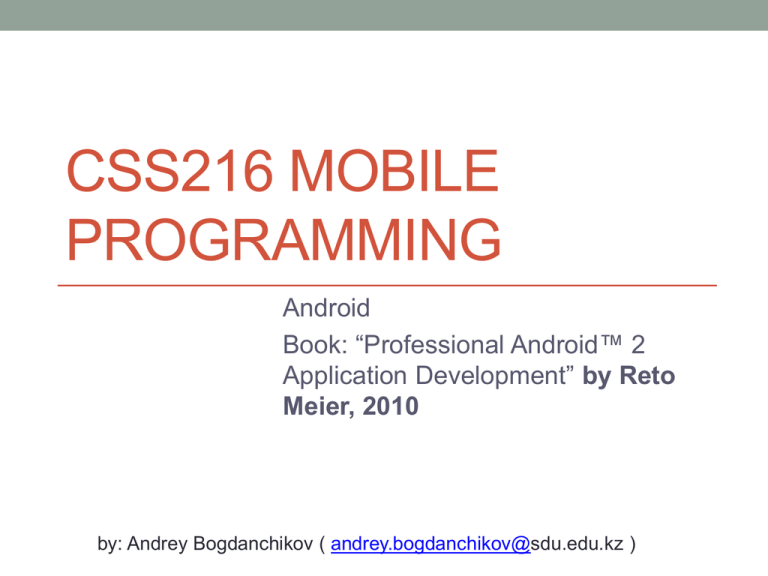
CSS216 MOBILE PROGRAMMING Android Book: “Professional Android™ 2 Application Development” by Reto Meier, 2010 by: Andrey Bogdanchikov ( andrey.bogdanchikov@sdu.edu.kz ) Outline • Introduction • A little background • Technology • Tools • Course Logistics • The End Introduction • Few words: Android, Google, Java • Android powers hundreds of millions of mobile devices in more than 190 countries around the world. • Why to develop? 1.5 billion downloads a month and growing. Get your apps in front of millions of users at Google's scale. A LITTLE BACKGROUND • In the days before Twitter and Facebook, when Google was still a twinkle in its founders’ eyes and dinosaurs roamed the earth, mobile phones were just that — portable phones small enough to fit inside a briefcase, featuring batteries that could last up to several hours. They did however offer the freedom to make calls without being physically connected to a landline. • Increasingly small, stylish, and powerful mobile phones are now as ubiquitous as they are indispensable. Hardware advancements have made mobiles smaller and more efficient while including an increasing number of peripherals. • After first getting cameras and media players, mobiles now include GPS systems, accelerometers, and touch screens. While these hardware innovations should prove fertile ground for software development, the applications available for mobile phones have generally lagged behind the hardware. Technology • Android sits alongside a new wave of mobile operating systems designed for increasingly powerful mobile hardware. Windows Mobile, the Apple iPhone, and the Palm Pre now provide a richer, simplified development environment for mobile applications. • Android offers new possibilities for mobile applications by offering an open development environment built on an open-source Linux kernel. Technology • Hardware access is available to all applications through a series of API libraries, and application interaction, while carefully controlled, is fully supported. • In Android, all applications have equal standing. Thirdparty and native Android applications are written with the same APIs and are executed on the same run time. Users can remove and replace any native application with a third-party developer alternative; even the dialer and home screens can be replaced. What you are going to do? • At least I hope write HelloWorld App. • At most: hmm… • Reality is: You will be familiar with features like: Camera, GPS, Bluetooth, Audio-Video, Network, Database and many more • Field is growing… Tools • Java SDK • Android Studio SDK • Android Handset(?) • Your Mind… • Hardworking… • Enthusiasm… Course Logistics • Grading Policy -Attendance (10%) -Final Examination Paper Based(10%) -Quizzes (10%) (in pop-up format 5mins) -Lab Assignments (30%) (10-12) -Midterm Paper Based (10%) -Course Project (30%) Site: instructor.sdu.edu.kz/~andrey Quizzes(10%) • 2 Questions On prev. topics or today’s lecture • 5 mins • During Lecture sessions, it means that it is better to attend lectures and listen them carefully Final(10%) and Midterm(10%) Exams • Paper Based Format for sure • Questions will be related to topics we discuss on lectures and in your Lab Assignments. Lab Assignments(30%) • During semester you are going to have 10-12 Lab Assignments • Labs are simply stuff like implement GPS, or Camera Capturing feature and so on depends on topic we are passing Course Project(30%) • 14th week submission period, check it out from course • • • • web-site Requirements will be posted on course web-site soon Group of 2 or individually Topic: list of topics will be available or you may choose to do other staff, in both cases we will do post processing. Presentation of projects will be at 15th week. THE END Thank you




